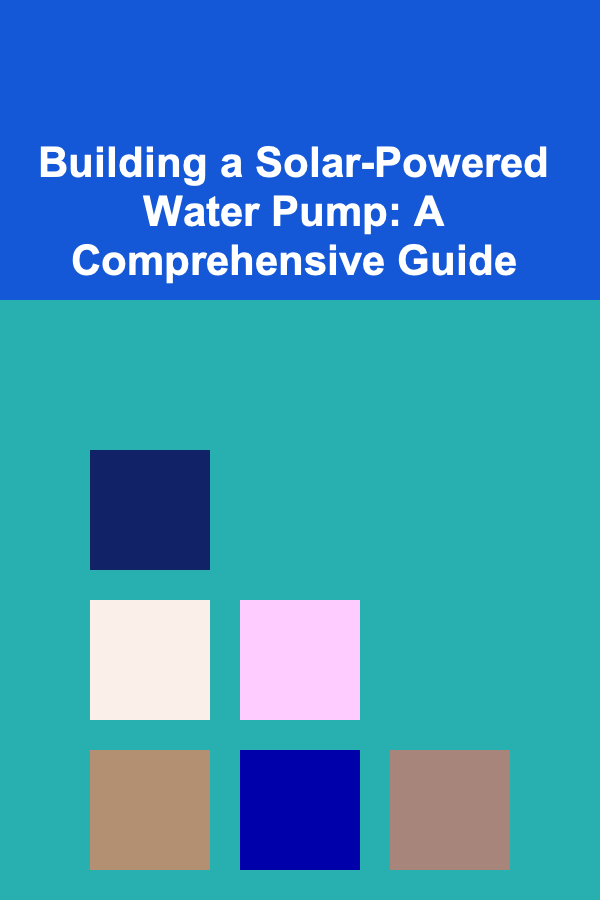
Building a Solar-Powered Water Pump: A Comprehensive Guide
ebook include PDF & Audio bundle (Micro Guide)
$12.99$11.99
Limited Time Offer! Order within the next:

Access to clean and reliable water sources is a fundamental requirement for human survival and sustainable development. In many regions, particularly those with limited grid electricity, traditional water pumping methods are either unavailable or prohibitively expensive. Solar-powered water pumps offer a viable and environmentally friendly alternative, harnessing the sun's energy to provide a consistent and sustainable water supply. This comprehensive guide will walk you through the process of designing, building, and maintaining a solar-powered water pump system, covering key considerations, component selection, and practical implementation tips.
Understanding Your Water Needs
Before embarking on the construction of a solar water pump, a thorough assessment of your water requirements is crucial. This assessment will dictate the size and specifications of the pump, solar panels, and other components. Consider the following factors:
- Water Demand: Determine the daily or weekly water volume needed for your intended use. This could be for irrigation, livestock watering, domestic consumption, or a combination of purposes. Accurate estimation is essential to avoid undersizing or oversizing the system.
- Water Source Characteristics: Analyze the water source, whether it's a well, a stream, a lake, or a storage tank. Measure the static water level (the distance from the surface to the water level when the pump is not running) and the drawdown (the difference between the static water level and the water level when the pump is running). These measurements are critical for calculating the total dynamic head (TDH).
- Total Dynamic Head (TDH): The TDH is the total vertical distance the pump needs to lift the water, plus any friction losses in the piping. It is calculated as: TDH = Static Head + Drawdown + Pressure Head + Friction Losses. Pressure head (if pressurizing a system) is converted to feet/meters of water using the appropriate conversion factor. Friction losses are dependent on pipe diameter, length, and flow rate. Consulting pipe friction loss charts or using online calculators is recommended for accurate determination.
- Flow Rate Requirements: Specify the desired flow rate (gallons per minute or liters per minute) that the pump needs to deliver. This is closely linked to the water demand and the operating time of the pump.
- Seasonal Variations: Account for seasonal fluctuations in water demand and solar irradiance. Irrigation needs, for instance, are likely to be higher during dry seasons. Similarly, solar panel output varies with the seasons and weather conditions. Designing for the worst-case scenario (lowest solar irradiance and highest water demand) ensures reliable performance year-round.
Failing to properly assess these factors can result in an inefficient and costly system. Take the time to gather accurate data and consider future expansion needs.
Diagram illustrating static head, drawdown, and discharge head.
Component Selection: Building Blocks of Your System
Choosing the right components is paramount for the performance and longevity of your solar water pump system. Key components include:
2.1. Solar Panels
Solar panels convert sunlight into electricity. Consider these factors when selecting solar panels:
- Panel Type: Monocrystalline panels are generally more efficient and have a longer lifespan compared to polycrystalline panels, although they tend to be more expensive. Thin-film panels are less efficient but can be more flexible and cost-effective for large-scale installations. Consider your budget and space constraints.
- Voltage and Current: The voltage and current output of the solar panels must match the voltage and current requirements of the pump or the charge controller and inverter (if used). Ensure compatibility to avoid damage to the equipment.
- Power Rating (Watts): The power rating of the solar panels determines the amount of electricity they can generate. Calculate the total wattage needed based on the pump's power consumption and the available sunlight hours. Account for losses due to shading, panel degradation, and other factors.
- Panel Efficiency: Higher efficiency panels produce more power per unit area, allowing you to reduce the overall footprint of the solar array.
- Environmental Conditions: Choose panels that are designed to withstand the specific environmental conditions in your area, such as extreme temperatures, high humidity, and strong winds.
2.2. Water Pump
Selecting the appropriate water pump is crucial for delivering the required water flow and head. Common types include:
- Submersible Pumps: Designed to be submerged in the water source, submersible pumps are efficient for lifting water from deep wells. They are typically more expensive but offer better performance in demanding applications.
- Surface Pumps: Located above the water source, surface pumps are suitable for shallow wells, streams, and tanks. They are generally less expensive but have limited suction capacity. Jet pumps and centrifugal pumps are common types of surface pumps.
- DC Pumps: Direct current (DC) pumps can be directly powered by solar panels without the need for an inverter, simplifying the system and improving efficiency. They are available in both submersible and surface configurations.
- AC Pumps: Alternating current (AC) pumps require an inverter to convert the DC power from the solar panels into AC power. They offer a wider range of options and are often used for larger-scale pumping applications.
- Pump Sizing: Use the calculated TDH and flow rate to select a pump with the appropriate performance curve. The pump's performance curve shows the relationship between flow rate and head. Choose a pump that operates efficiently within your desired operating range.
Always check the pump's voltage and power requirements and ensure they are compatible with the solar panel output or the inverter output.
2.3. Charge Controller (Optional)
A charge controller regulates the voltage and current from the solar panels to protect the batteries (if used) from overcharging and extending their lifespan. If you are running the pump directly from the solar panels (without batteries), a charge controller might not be necessary, but it can still provide over-voltage protection.
- PWM (Pulse Width Modulation) Charge Controllers: Less expensive but less efficient, PWM controllers are suitable for smaller systems.
- MPPT (Maximum Power Point Tracking) Charge Controllers: More efficient and capable of extracting more power from the solar panels, MPPT controllers are recommended for larger systems.
2.4. Inverter (If Using an AC Pump)
An inverter converts the DC power from the solar panels (or batteries) into AC power to run an AC pump. Select an inverter with sufficient power capacity to handle the pump's starting and running load.
- Pure Sine Wave Inverters: Provide clean and stable AC power, ideal for sensitive electronic equipment and motors.
- Modified Sine Wave Inverters: Less expensive but may not be suitable for all AC pumps. Check the pump manufacturer's recommendations.
- Sizing: The inverter should be rated for at least 1.5 times the pump's running wattage to handle the inrush current during startup.
2.5. Batteries (Optional)
Batteries store excess solar energy for use when sunlight is unavailable, providing continuous water pumping even at night or on cloudy days. However, adding batteries increases the cost and complexity of the system. Consider the following:
- Battery Type: Lead-acid batteries (flooded, AGM, or gel) are a common and cost-effective option. Lithium-ion batteries offer longer lifespan and higher energy density but are more expensive.
- Battery Capacity: Calculate the required battery capacity based on the pump's power consumption, the desired runtime without sunlight, and the depth of discharge (DOD) of the batteries. Avoid discharging batteries below their recommended DOD to prolong their lifespan.
2.6. Wiring, Plumbing, and Other Accessories
Don't overlook the importance of high-quality wiring, plumbing, and other accessories:
- Wiring: Use appropriately sized wiring to handle the current and voltage of the system. Use outdoor-rated wiring for exposed connections.
- Plumbing: Use PVC, PEX, or other suitable piping materials for connecting the pump to the water source and the distribution system. Ensure proper fittings and connections to prevent leaks.
- Fittings: Use appropriate fittings, such as check valves (to prevent backflow), ball valves (for isolation), and pressure relief valves (for safety).
- Water Tank (Optional): A water tank provides storage capacity for water, allowing you to pump water during peak sunlight hours and use it later when needed.
- Float Switch (Optional): A float switch can automatically turn the pump on and off based on the water level in the tank, preventing overfilling or running the pump dry.
- Filters (Optional): Install filters to remove sediment and debris from the water, protecting the pump and improving water quality.
- Mounting Structures: Durable and secure mounting structures are essential for safely installing solar panels. They should be able to withstand wind loads and other environmental factors.
System Design and Installation
Careful system design and installation are crucial for optimal performance and safety. Follow these steps:
3.1. Site Assessment
- Sunlight Availability: Assess the amount of sunlight available at the installation site throughout the year. Use a solar pathfinder or online tools to determine shading patterns and optimal panel orientation.
- Panel Orientation and Tilt: Orient the solar panels towards the south (in the Northern Hemisphere) or north (in the Southern Hemisphere) to maximize sunlight exposure. Adjust the tilt angle based on your latitude and the season. A general rule of thumb is to set the tilt angle equal to your latitude for year-round performance.
- Water Source Accessibility: Ensure easy access to the water source for pump installation and maintenance.
- Component Placement: Plan the placement of all components, considering factors such as proximity to the water source, sunlight exposure, and security.
3.2. Wiring and Connections
- Wiring Diagram: Create a detailed wiring diagram showing all connections between the solar panels, charge controller (if used), inverter (if used), batteries (if used), and pump. Follow the manufacturer's instructions for each component.
- Proper Grounding: Ground all metallic components of the system to protect against electrical shock.
- Secure Connections: Use waterproof connectors and ensure all connections are secure and properly insulated.
- Polarity: Pay close attention to polarity when connecting solar panels and batteries. Reversing the polarity can damage the equipment.
3.3. Pump Installation
- Submersible Pump Installation: Carefully lower the submersible pump into the well, ensuring the cable is properly supported and protected. Use a safety rope to prevent the pump from falling to the bottom of the well.
- Surface Pump Installation: Mount the surface pump on a stable platform near the water source. Ensure the suction line is properly sealed to prevent air leaks.
- Plumbing Connections: Connect the pump to the plumbing system using appropriate fittings and piping materials. Use Teflon tape to seal threaded connections.
3.4. Testing and Commissioning
- Voltage and Current Testing: Use a multimeter to verify the voltage and current at various points in the system.
- Pump Performance Testing: Measure the flow rate and pressure of the pump to ensure it meets the design specifications.
- Leak Testing: Check all plumbing connections for leaks.
- System Monitoring: Install monitoring equipment to track the system's performance over time. This can include voltage and current meters, flow meters, and water level sensors.
Maintenance and Troubleshooting
Regular maintenance is essential for ensuring the long-term reliability of your solar water pump system. Here are some key maintenance tasks:
- Solar Panel Cleaning: Clean the solar panels regularly to remove dust, dirt, and debris that can reduce their efficiency. Use a soft cloth and mild detergent.
- Pump Inspection: Inspect the pump regularly for signs of wear and tear. Check the impeller, seals, and bearings.
- Wiring Inspection: Inspect the wiring for loose connections, corrosion, and damage.
- Battery Maintenance (If Applicable): Check the water level in flooded lead-acid batteries regularly and add distilled water as needed. Clean the battery terminals to prevent corrosion.
- Filter Cleaning or Replacement: Clean or replace water filters regularly to prevent clogging.
Troubleshooting Common Problems:
- Pump Not Working:
- Check the solar panels for shading.
- Check the wiring connections.
- Check the fuse or circuit breaker.
- Check the pump motor for damage.
- Low Flow Rate:
- Check for clogs in the pump or piping.
- Check the water level in the well or tank.
- Check the solar panel output.
- Check the pump for wear and tear.
- Pump Cycling On and Off:
- Check for air leaks in the suction line.
- Check the water level in the well or tank.
- Check the pressure switch (if applicable).
Warning: Always disconnect the power supply before performing any maintenance or troubleshooting on the electrical components of the system. Consult a qualified electrician if you are not comfortable working with electrical wiring.
Safety Considerations
Safety should always be a top priority when building and operating a solar water pump system.
- Electrical Safety:
- Follow all electrical codes and regulations.
- Use properly sized wiring and connectors.
- Ground all metallic components of the system.
- Use a Ground Fault Circuit Interrupter (GFCI) outlet for all AC connections.
- Disconnect the power supply before performing any maintenance or troubleshooting.
- Water Safety:
- Ensure the water source is free from contamination.
- Install filters to remove sediment and debris.
- Test the water regularly for bacteria and other contaminants.
- Disinfect the water if necessary.
- Mechanical Safety:
- Use appropriate tools and equipment.
- Wear safety glasses and gloves.
- Follow the manufacturer's instructions for all components.
- Securely mount all components to prevent them from falling or moving.
Cost Analysis and ROI
Building a solar-powered water pump system involves upfront costs, but it can offer significant long-term savings compared to traditional pumping methods. Consider the following factors when evaluating the cost and return on investment (ROI):
- Initial Costs:
- Solar panels
- Water pump
- Charge controller (if used)
- Inverter (if using an AC pump)
- Batteries (if used)
- Wiring and plumbing materials
- Mounting structures
- Installation labor (if applicable)
- Operating Costs:
- Maintenance costs (cleaning, repairs, replacements)
- Battery replacement (if applicable)
- Savings:
- Elimination of electricity bills (if replacing a grid-powered pump)
- Reduced fuel costs (if replacing a diesel-powered pump)
- Increased crop yields (due to reliable irrigation)
- Reduced labor costs (due to automated pumping)
Calculate the payback period by dividing the initial costs by the annual savings. Consider the lifespan of the components and the potential for future cost savings. Solar-powered water pumps can be a cost-effective and environmentally friendly solution for providing reliable water supply in many situations.
Conclusion
Building a solar-powered water pump is a challenging but rewarding project. By carefully planning your system, selecting the right components, and following proper installation procedures, you can create a reliable and sustainable water supply for your needs. Remember to prioritize safety and perform regular maintenance to ensure the long-term performance of your system. As technology advances and costs continue to decline, solar-powered water pumps are becoming an increasingly attractive option for providing clean and accessible water in a wide range of applications.

How to Prepare Your Closet for Winter Layers
Read More
How to Share Your Jewelry Organization Tips with Friends
Read More
How to Use a Rolling Cart for Flexible Storage Solutions
Read More
How to Master Online Dating Profiles
Read More
How to Save Money on Airport Transfers: A Comprehensive Guide
Read More
How to Knit Fair Isle Patterns Without Mistakes
Read MoreOther Products

How to Prepare Your Closet for Winter Layers
Read More
How to Share Your Jewelry Organization Tips with Friends
Read More
How to Use a Rolling Cart for Flexible Storage Solutions
Read More
How to Master Online Dating Profiles
Read More
How to Save Money on Airport Transfers: A Comprehensive Guide
Read More